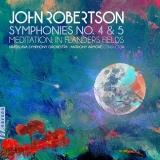 John Robertson: Symphonien Nr. 4 op. 73 & Nr. 5 op. 76 + In Flanders Fields op. 70; Bratislava Symphony Orchestra, Anthony Armoré; 1 CD Navona Records NV6325; Aufnahmen 07/2019 + 03/2020, Veröffentlichung 08/01/2021 - Rezension von Remy Franck
John Robertson: Symphonien Nr. 4 op. 73 & Nr. 5 op. 76 + In Flanders Fields op. 70; Bratislava Symphony Orchestra, Anthony Armoré; 1 CD Navona Records NV6325; Aufnahmen 07/2019 + 03/2020, Veröffentlichung 08/01/2021 - Rezension von Remy Franck

Der neuseeländisch-kanadische Komponist John Robertson hat mit seinen Symphonien Nr. 4 und 5 zwei ca. halbstündige Werke komponiert, die dem neoklassischen Stil zuzurechnen sind, auch wenn sie orchestral streckenweise recht üppig sind. Insbesondere der dritte Satz der Vierten ist sehr energisch, selbst wenn er auch feinere, lyrische Momente enthält. Der Mittelsatz, ein Andante ist ebenfalls sehr kantabel, unterschwellig mysteriös und ganz bezaubernd, darin dem Adagio der Fünften sehr ähnlich, auch wenn der Satz wie überhaupt die Fünfte in den beiden ersten Sätzen deutlich ernster und schwermütiger wirkt als die Vierte. Der letzte Satz ist beschwingt und benutzt ein kräftiges Blech, das sich gegen die Streicher stellt. Die Symphonie endet mit der jubilierenden Coda.
Die beiden Symphonien zeichnen sich durch eine einfallsreiche Musik aus. Das kurze Stück In Flanders Fields ist eine Meditation für Orchester und Erzähler, in der für mein Empfinden die Narration eher stört als bereichert.
Das Symphonieorchester aus Bratislava spielt engagiert in allen drei Werken, und die Tonaufnahme ist angenehm räumlich und transparent.
With his Symphonies Nos. 4 and 5, the New Zealand-Canadian composer John Robertson has composed two works of about half an hour that can be attributed to the neo-classical style, even if they are orchestrally quite opulent in places. The third movement of the Fourth in particular is very energetic, yet it also contains finer, lyrical moments. The middle movement, an Andante, is also very cantabile, subliminally mysterious and quite enchanting, in that it is very similar to the Adagio of the Fifth, even if the movement, like the Fifth in general, seems much more serious and melancholy in the first two movements than the Fourth. The last movement is buoyant and uses a powerful brass section that opposes the strings. The symphony ends with the jubilant coda.
The two symphonies are characterised by imaginative music. The short piece In Flanders Fields is a meditation for orchestra and narrator in which, to my mind, the narration interferes rather than enriches.
The Bratislava Symphony Orchestra plays with commitment in all three works, and the sound recording is pleasantly spacious and transparent.
























